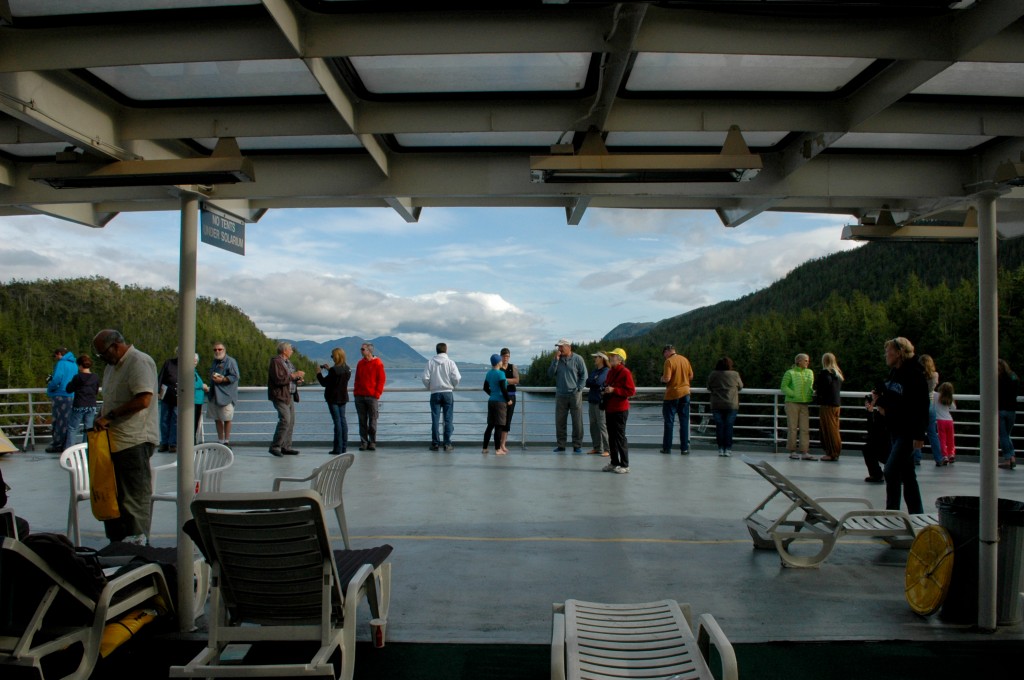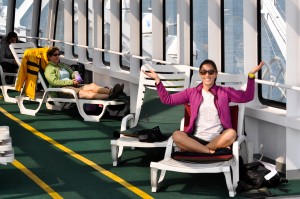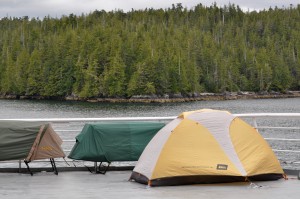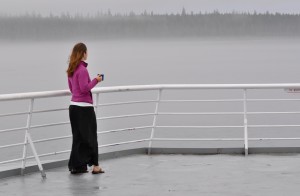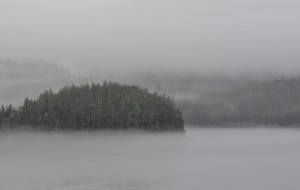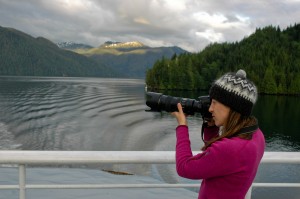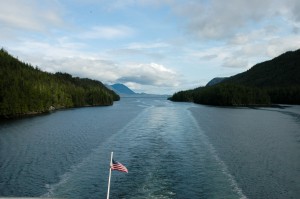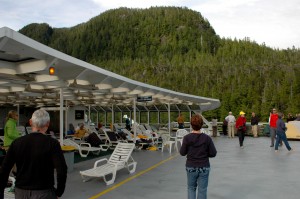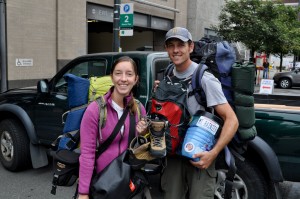The solarium crowd is a strange community of travelers. Our resident neighbors are very different from the typical cruise ship goers. They are the motley variety, rugged, independent, and self-sustaining – the types who don’t mind sleeping out in the open or going three days without a shower.
We have embarked on the Alaska State Ferry – a journey that will take us from Bellingham, Washington to Skagway, Alaska over the next three days through some of the most scenic waterways on the planet.
Those of us riding in the solarium sleep in a big open room made of windows from top to bottom. Since the room is built on the aft part of the ship, it’s quite well protected from the wind and heat lamps keep the room cozy, even at night. We watch the scenery unfold from the deck chairs that also serve as our beds (along with the help of camping pads and sleeping bags). But one fellow traveler has slung a hammock and others have brought their own cots. The ferry is an informal mode of transportation. Tents are allowed on the deck just beyond the solarium and experienced travelers have brought enough duct tape to secure their temporary homes during high winds.
Over the course of the cruise, pockets of people get to know one another, forging little clusters of friendships that are based more on proximity than common interest.
The advantage to traveling this way is cost. The famed Inside Passage is a route frequented by mega cruise ships, but rather than paying thousands of dollars for the ride, our deck chairs cost a mere $363 each. OK, so there’s no midnight buffet, luxury suites, swimming pools or Vegas style shows, but who needs that when the scenery is all the entertainment a person could want?
The ferry itself is quite well equipped. Amanda was most excited about the collection of jigsaw puzzles, and there is a restaurant, a bar, a cafeteria, a theater, showers, laundry facilities and even modest staterooms (approximately double the cost of our solarium chairs)
Our departure isn’t quite a scene from The Love Boat – we didn’t see anyone throwing streamers from the deck or loved ones waving from shore – and as soon as we were under way, people turned to their books, playing cards and the kind of relaxing that can only come from knowing you have nothing to do for three days but look out the window.
The first morning, I awake with joy instead of my normal dread. It is 4:30 AM – the hour typically reserved for crying babies and those unfortunate souls who must rise for an ungodly morning shift. But in July on the Inside Passage it’s already getting light, and the world is filled with wonder. I manage to sit up long enough to soak in the rocky shoreline slathered with evergreens. Our ferry snakes through a narrow neck of land the feels close enough that I could hit it with a stone. I prop my chair up and struggle to stay awake. I want to see more. I don’t want to miss a single minute of this voyage, but the Salish Sea is so tranquil and I have trouble staying awake on a boat even in the best of times.
A few hours later, there is a thunderous noise. The fog has closed in leaving Vancouver Island shrouded in featureless nothing. The ship blows her horn again to sound her position. Around us, most of the passengers are still asleep and no one seems to mind their slack jawed snoozing or scattered gear. The smell of bacon has been wafting for hours adding to my happy state of mind.
By mid morning, the fog lifts and we see mile upon mile of unspoiled shoreline without a house in sight. A pair of harbor porpoise cruise in our wake. Amanda knits. Jeff writes and reads, but mostly we’re on the lookout for whales. We have a backrub on the line for the person who spots the first one. It doesn’t take long. By the end of the day, we’ve had three humpback sightings along with numerous bald eagles, and harbor seals.
The passageways are an endless labyrinth. Almost all of them are void of human life, pollution or cut trees. It’s impossible to tell what’s an island and what’s the mainland, or even where you are. Mile after mile we see hillsides coated with trees and unscarred shoreline.
Toward the end of the day the terrain grows increasingly mountainous with peaks dotted in mid summer snow. Melting ice caps means an abundance of waterfalls only adding to the grandeur. In the late afternoon, there are so many salmon jumping that it’s almost impossible not to look up from your book and see a fish out of the water somewhere.
This is the slow road. This is solarium travel. It is the chance to unwind our tightly wound existence. The days grow longer and the shoulders grow more relaxed with each passing mile. I don’t want to miss a single minute of this voyage. But the heat lamp above my deck chair bed would make me sleepy even in the best of times.
